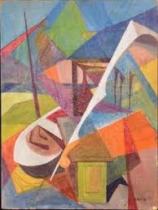Blavatsky and Abstract Art

The website, Walking Paris with Henry Miller, gives some details about the influence abstract artist Frederick I. Kann (1884-1965) may have had on the American novelist, Henry Miller. Kann was one of Miller’s closest friends and benefactors during his early years in Paris [in the 1930s] and he makes an appearance in Tropic of Cancer as “Kruger.” In his novel, Miller paints Kann as a “spiritual-minded individual” eager for an audience to listen to his obsessive prattling over esoteric subjects. Miller shared several of Kann’s theosophical and astrological interests and, as he was then living hand-to-mouth and often homeless, was willing to exchange an obliging ear for the occasional meal or a place to sleep for the night.In 1941 they met again when Miller was making a tour of America and stopped in Kansas City where Kann was teaching at the Kansas City Art Institute. Kann’s esoteric bent had led him to Freemasonry and he regaled Miller in his customary manner with discussions of Tibet, Madame Blavatsky and Krishnamurti. Miller stayed for a weekend and before he left Kann presented him with a prized copy of The Phoenix by Manly P. Hall.Kann, who was born in Czechoslovakia, had emigrated to Canada in 1910, by 1928 he was living in Paris where he taught and exhibited his paintings. In 1934 he was part of a show that also included works by Delaunay, Kandinsky, Moholy-Nagy, and Mondrian, among many others. He returned to America in 1936 and settled in Los Angeles in 1942. The catalog accompanying a retrospective of his work in 2007, “Frederick Kann: Creative Spirit, Visionary Mind,” notes that “His name appeared alongside some of the most important modern masters of the 20th century, yet the exact character of his work remained unknown until very recently. Kann’s paintings reflect the international impulse toward abstraction during the 1920s and 1930s. His emphasis was not only on the formal elements of color, form, and line, but how they could be used to convey spiritual, mystical, scientific, and cosmological ideas. In 1938 Kann wrote, ‘Nature is not only the sensual perception of distance, but the intelligent penetration of its interior working process.’”The rest of the account of the interaction between Kann and Miller can be read here.
Frederick I. Kann (1884-1965) – Henry Miller Blavatsky e l’Arte Astratta
Il sito web Walking Paris with Henry Miller offre alcuni dettagli riguardo l’influenza che l’artista astratto Frederick I. Kann (1884-1965) può avere avuto sul romanziere americano Henry Miller. Kann fu uno dei più intimi amici e benefattori di Miller durante i suoi primi anni a Parigi negli anni Trenta e fa la sua comparsa in Tropico del Cancro nel personaggio di Kruger. Nel suo romanzo, Miller dipinge Kann come un “individuo spirituale” desideroso di avere un pubblico che ascoltasse le sue chiacchiere esoteriche. Miller condivideva con Kann diversi interessi teosofici ed astrologici e, vivendo spesso alla giornata e senza una casa, era disposto a scambiare un orecchio cortese con un pasto occasionale o un posto dove andare a dormire per la notte. Nel 1941 si incontrarono nuovamente quando Miller era impegnato in un tour in America e fece sosta a Kansas City dove Kann insegnava al Kansas City Art Institute. La piega esoterica avviò Kann alla Massoneria e coi suoi soliti modi deliziò Miller con discussioni sul Tibet, Madame Blavatsky e Krishnamurti. Miller rimase per un weekend e prima di partire Kann gli regalò una preziosa copia di La Fenice, di Manly P. Hall.
Kann, che era nato in Cecoslovacchia e dovette emigrare in Canada nel 1910, dal 1928 viveva a Parigi dove insegnava ed esponeva i suoi dipinti. Nel 1934 fece parte di una mostra che includeva anche lavori di Delaunay, Kandinsky, Moholy-Nagy e Mondrian, fra i tanti. Ritornò in America nel 1936 e si stabilì a Los Angeles nel 1942. Il catalogo che nel 2007 accompagnava una retrospettiva dei suoi lavori, “Frederick Kann: Creative Spirit, Visionary Mind,” riporta che
“Il suo nome apparve accanto a quello di alcuni dei più importanti maestri del Ventesimo Secolo, sebbene l’esatto carattere dei suoi lavori rimase sconosciuto fino a pochissimo tempo fa. I quadri di Kann riflettono la spinta internazionale verso l’astrazione durante gli anni Venti e Trenta del Novecento. La sua enfasi non era solo relativa agli elementi formali del colore, della forma e della linea, ma al modo in cui essi potevano essere usati per trasmettere idee spirituali, mistiche, scientifiche e cosmologiche. Nel 1938 Kann scrisse, ‘La natura non è solo percezione sensuale della distanza, ma l’intelligente penetrazione del suo modo interiore di operare.’”
Il seguito del resoconto dell’interazione tra Kann e Miller può essere letto qui.






